Psychological disorders, also known as mental disorders, impact a person's thinking, feelings, behavior, or mood. These conditions can also affect many areas of life, such as work, relationships, and self-care.
Understanding the different types of psychological disorders helps us recognize and support those affected. Let's explore the main categories and their characteristics.
I. Understanding Psychological Disorders
Psychological disorders are conditions that affect a person's mental health and daily functioning. They can lead to significant distress and impair various aspects of life.

Definition of Psychological Disorders
A psychological disorder is characterized by disturbances in an individual's emotions, behavior, or thoughts. These disturbances cause distress and interfere with daily life activities.
Importance of Understanding Psychological Disorders
Understanding psychological disorders is important for:
- Recognizing Symptoms: Identifying the signs and symptoms helps in seeking timely treatment.
- Reducing Stigma: Education can alleviate the stigma surrounding mental health issues. This makes it easier for individuals to seek help.
- Providing Support: Knowing about these disorders enables us to support friends or family members who may be affected.
II. Anxiety Disorders
Anxiety disorders are marked by excessive fear or anxiety. Fear is a response to a real or perceived immediate threat. Anxiety, on the other hand, is worry about a future threat.

Types of Anxiety Disorders
- Generalized Anxiety Disorder (GAD): This disorder involves constant and excessive worry regarding various aspects of life, such as work, health, or social situations. People with GAD find it hard to control their worry and may experience physical symptoms like restlessness or fatigue.
- Panic Disorder: Involves sudden and repeated panic attacks, which are intense periods of fear. These attacks can cause physical symptoms like chest pain, heart palpitations, or difficulty breathing.
- Social Anxiety Disorder: Also known as social phobia. It involves an intense fear of social situations. People with this disorder worry about being judged or embarrassed in public.
- Specific Phobias: Involves an intense, irrational fear of particular objects or situations, such as spiders (arachnophobia) or heights (acrophobia).
III. Mood Disorders
Mood disorders primarily affect a person’s emotional state, leading to periods of extreme sadness or excessively elevated mood.
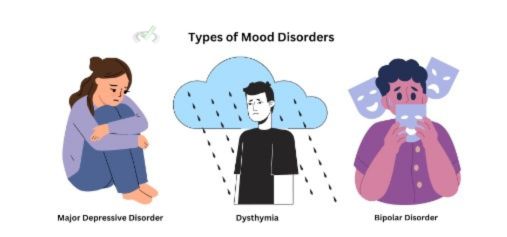
Types of Mood Disorders
- Major Depressive Disorder (MDD): This is marked by persistent feelings of sadness and loss of interest in activities. Other physical symptoms such as fatigue, appetite, and sleep changes also manifest. It can significantly impair daily functioning and is more than feeling "down."
- Bipolar Disorder: This is marked by episodes of depression and mania. Mania is a state of abnormally elevated mood, energy, and activity levels. Bipolar disorder has different types, including Bipolar I (with full manic episodes) and Bipolar II (with less severe hypomanic episodes).
- Dysthymia (Persistent Depressive Disorder): A chronic form of depression with less severe symptoms than major depression but lasts for a longer period, often years.
IV. Psychotic Disorders
Psychotic disorders involve distorted thinking and perception. The most well-known psychotic disorder is schizophrenia.
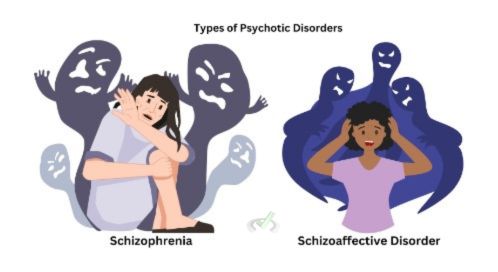
Types of Psychotic Disorders
- Schizophrenia: Characterized by symptoms such as hallucinations (seeing or hearing things that are not real), delusions (false beliefs), and disorganized thinking. Schizophrenia can significantly impact a person's ability to function in daily life.
- Schizoaffective Disorder: A condition that includes symptoms of both schizophrenia and a mood disorder (such as depression or bipolar disorder). This means individuals experience a combination of mood swings and psychotic symptoms.
V. Eating Disorders
Eating disorders involve extreme emotions, attitudes, and behaviors related to food and body image.
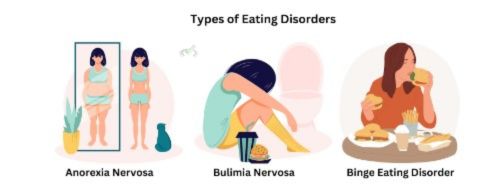
Types of Eating Disorders
- Anorexia Nervosa: Characterized by an intense fear of gaining weight and a distorted body image. Individuals with anorexia severely restrict their food intake, leading to significant weight loss and health issues.
- Bulimia Nervosa: Involves episodes of binge eating followed by compensatory behaviors like vomiting, excessive exercise, or fasting. Unlike anorexia, individuals with bulimia often maintain a normal weight, which can make the disorder less noticeable.
- Binge Eating Disorder: This is marked by recurrent episodes of eating large quantities of food, often quickly and to the point of discomfort. Unlike bulimia, there are no regular compensatory behaviors like purging.
VI. Personality Disorders
Personality disorders are characterized by enduring patterns of behavior, cognition, and inner experience that deviate significantly from cultural expectations. These patterns are inflexible and pervasive, causing distress or impairment.
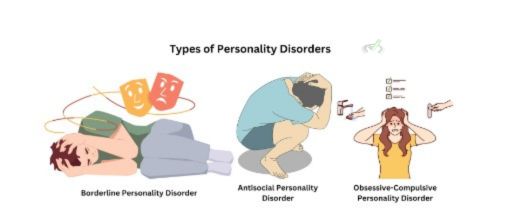
Types of Personality Disorders
- Borderline Personality Disorder (BPD): Characterized by instability in relationships, self-image, and emotions. People with BPD may experience intense episodes of anger. They may also have depression and anxiety that can last from a few hours to a few days. They may also have a fear of abandonment.
- Antisocial Personality Disorder: Involves a disregard for the rights of others, often violating societal norms and laws. People with this disorder may engage in deceitful, manipulative, or unlawful behavior, and they usually lack empathy.
- Obsessive-Compulsive Personality Disorder (OCPD): Characterized by a preoccupation with orderliness, perfectionism, and control. This is different from Obsessive-Compulsive Disorder (OCD), which involves unwanted repetitive thoughts and behaviors.
VII. Neurodevelopmental Disorders
Neurodevelopmental disorders are a group of conditions that begin in childhood. They often affect personal, social, academic, and occupational functioning.
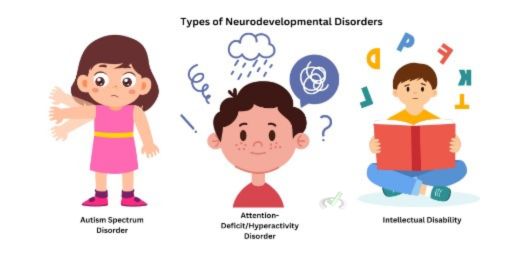
Types of Neurodevelopmental Disorders
- Autism Spectrum Disorder (ASD): A developmental disorder that affects communication and behavior. Symptoms can vary from person to person but may include challenges with social interactions, repetitive behaviors, and restricted interests.
- Attention-Deficit/Hyperactivity Disorder (ADHD): Involves patterns of inattention, hyperactivity, and impulsivity. These are more severe than typically observed in individuals at a similar level of development.
- Intellectual Disability: Characterized significant limitations in intellectual functioning and adaptive behavior. This covers many everyday social and practical skills. This includes difficulties in learning, reasoning, and problem-solving.
VIII. Trauma-Related Disorders
Trauma-related disorders are psychological disorders that arise after experiencing a traumatic event.
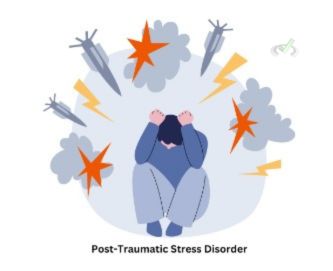
Types of Trauma-Related Disorders
- Post-Traumatic Stress Disorder (PTSD): Occurs after experiencing or witnessing a traumatic event. This may include a natural disaster, serious accident, or assault. Symptoms include flashbacks, nightmares, severe anxiety, and uncontrollable thoughts about the event.
IX. Substance-Related and Addictive Disorders
Substance-related and addictive disorders involve the excessive use of substances like drugs and alcohol or engaging in behaviors like gambling, which can become compulsive.
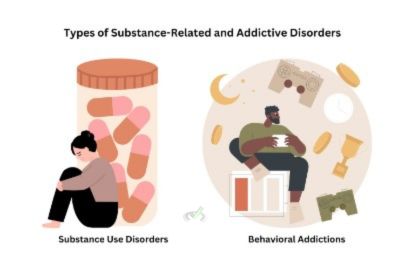
Types of Substance-Related and Addictive Disorders
- Substance Use Disorders: Involve the harmful use of substances such as alcohol, drugs, or prescription medications. These disorders can lead to addiction, characterized by the inability to control use even with the negative consequences.
- Behavioral Addictions: Involves compulsive engagement in behaviors such as gambling, internet use, or shopping, even when these behaviors cause harm.
X. Bridge/Overlap
Understanding psychological disorders connects to other important areas in healthcare, psychology, and social sciences.
Healthcare
Psychological disorders have significant implications for healthcare.
- Diagnosis and Treatment: Accurate diagnosis is important for effective treatment. This can include psychotherapy, medication, or a combination of both. Understanding disorders helps healthcare professionals provide better care.
- Public Health: Mental health is a public health issue. It affects community well-being, economic costs, and healthcare systems. Raising awareness and providing resources can improve overall health and reduce stigma.
Psychology
The study of psychological disorders is a fundamental part of psychology.
- Clinical Psychology: Focuses on the diagnosis and appropriate treatment of mental, emotional, and behavioral disorders. This field involves therapy techniques and approaches to help individuals manage or overcome their conditions.
- Psychopathology: The study of abnormal behavior and mental disorders. Understanding the underlying causes, such as genetics, brain chemistry, and life experiences, is crucial for developing effective treatments.
Social Sciences
Social factors play a critical role in the development and management of psychological disorders.
- Sociology: Explores how societal influences, such as culture, economic status, and relationships, impact mental health. It also studies the social implications of mental health issues, such as stigma and access to care.
- Anthropology: Examines how different cultures perceive and deal with psychological disorders. This helps in understanding cultural variations in symptoms and treatment approaches.
Education
Educational settings are important for identifying and supporting students with psychological disorders.
- Special Education: Schools often provide special education services to support students with neurodevelopmental disorders like ASD and ADHD. Early intervention can significantly improve outcomes.
- Mental Health Programs: Schools are increasingly incorporating mental health education and resources to support students' well-being and address issues like anxiety and depression.
Public Policy
Public policy is important in addressing psychological disorders.
- Mental Health Laws: Laws and policies are essential in order to protect the rights of individuals with psychological disorders and ensure access to treatment. These include regulations on insurance coverage and workplace accommodations.
- Advocacy: Advocacy groups work to raise awareness, reduce stigma, and improve services for those with mental health issues. They also lobby for better funding and research in mental health.
Neuroscience
The field of neuroscience explores the brain's role in psychological disorders.
- Brain Chemistry: Imbalances in neurotransmitters, the chemicals in the brain that transmit signals, are linked to various psychological disorders. For example, serotonin imbalances are associated with depression.
- Brain Structure: Structural differences in the brain, such as in the amygdala or hippocampus, can be involved in disorders like PTSD or schizophrenia.
Genetics
Genetics influence how susceptible someone is to psychological disorders. Many psychological disorders have genetic components, meaning they can run in families.
For instance, bipolar disorder and schizophrenia are more common in individuals with a family history of these conditions.
XI. Wrap Up/Key Terms
Let's summarize the key points:
- Psychological Disorders: Conditions affecting thinking, feeling, behavior, or mood, causing distress and impairing daily functioning.
- Anxiety Disorders: Disorders characterized by excessive fear or anxiety, such as GAD, panic disorder, and phobias.
- Mood Disorders: Disorders affecting emotional states, like depression and bipolar disorder.
- Psychotic Disorders: Disorders involving distorted thinking and awareness, such as schizophrenia.
- Eating Disorders: Disorders involving extreme emotions and behaviors related to weight and food, like anorexia and bulimia.
- Personality Disorders: Disorders characterized by enduring patterns of behavior and cognition that deviate from cultural expectations.
- Neurodevelopmental Disorders: Disorders that begin in childhood and affect development, like ASD and ADHD.
- Trauma-Related Disorders: Disorders that arise after experiencing traumatic events, such as PTSD.
- Substance-Related and Addictive Disorders: Disorders involving harmful use of substances or compulsive behaviors, like addiction.
XII. Practice
Test your understanding with these questions:
Sample Practice Question 1
Which type of psychological disorder is characterized by intense fear of social situations?
A. Generalized Anxiety Disorder
B. Social Anxiety Disorder
C. Obsessive-Compulsive Disorder
D. Bipolar Disorder
Ans. B
Social Anxiety Disorder is characterized by an extreme fear of being judged or embarrassed in social settings.
Sample Practice Question 2
What is the difference between the psychological disorders Anorexia Nervosa and Bulimia Nervosa?
A. Anorexia involves binge eating; Bulimia does not.
B. Bulimia involves purging behaviors; Anorexia does not.
C. Anorexia is characterized by excessive exercise; Bulimia is not.
D. There is no difference; both are the same disorder.
Ans. B
While both disorders involve concerns about weight and eating, Bulimia Nervosa specifically includes episodes of binge eating. Compensatory behaviors like vomiting or excessive exercise then follow it.







 To help you achieve your goal MCAT score, we take turns hosting these
To help you achieve your goal MCAT score, we take turns hosting these 





















 reviews on TrustPilot
reviews on TrustPilot